Riley Bailey
Ukrainian military officers offered notably frank and direct commentary about the prospects of further Ukrainian advances in western Zaporizhia Oblast and indicated that the series of prepared Russian defensive positions immediately ahead and further south of the Ukrainian advance may be less challenging to Ukrainian forces. Ukrainian Tavriisk Group of Forces Commander Brigadier General Oleksandr Tarnavskyi, who commands the Ukrainian grouping in southern Ukraine, discussed Ukraine’s counteroffensive in an interview with The Guardian on September 2.[1] Tarnavskyi stated that Ukrainian forces have decisively breached Russian forces’ “first line of defense” and that he expects faster Ukrainian gains as Ukrainian forces press on a weaker “second line” of defense.[2] Ukrainian forces have advanced up to the next series of prepared Russian defensive positions in certain areas in the Robotyne area in western Zaporizhia Oblast, although many Russian sources assert that these positions are the first, not the second, defensive layer in a multi-echeloned Russian defense in southern Ukraine.[3] Ukrainian officials and Russian milbloggers are using different terminology to describe the same positions. Russian sources characterize the first series of positions that Ukrainian forces have previously breached as a forward line without giving it an ordinal number, and the series Ukrainian forces are currently approaching as the first main line of defenses — while Ukrainian forces characterize these positions as Russia’s second line of defenses.
Tarnavskyi stated that Russian forces devoted 60 percent of their time and resources into building the series of defensive positions that Ukrainian forces have now breached and only 20 percent each to the two subsequent defensive layers further south.[4] This breached series of Russian defensive positions consists of a system of interconnected Russian trenches and dugouts guarded by anti-tank ditches and dense minefields, and Tarnavskyi’s reporting supports ISW’s previous observation that Russian forces may have not extended similarly challenging preparations throughout subsequent series of defensive layers, particularly regarding the density of minefields.[5] Russian defensive positions are not uniform in strength across the frontline in western Zaporizhia Oblast, and Tarnavskyi’s description of weaker Russian defensive positions may refer only to the immediate Robotyne area. Tarnavskyi also commented on the weight of Ukrainian efforts elsewhere in southern Ukraine and suggested that the Ukrainian advance in western Zaporizhia Oblast is an operational priority.[6]
Ukrainian military officials particularly noted that advancing Ukrainian forces can operate more freely in areas with sparser Russian minefields. Ukrainian Tavriisk Group of Forces Spokesperson Oleksandr Shtupun stated on September 3 that minefields near the next series of Russian defensive positions are less dense than the initial defensive layer that Ukrainian forces advanced through.[7] Shtupun and Tarnavskyi both stated that Ukrainian forces are deploying more vehicles in these areas and maneuvering more equipment and troops towards the next Russian defensive layer, but they acknowledged that minefields will still present a significant threat.[8] Tarnavskyi stated that Ukrainian forces spent more time on mine clearing than they expected to at the beginning of the counteroffensive and that consistent Russian artillery and aviation fire forced Ukrainian infantry to conduct mine clearing only at night.[9] Shtupun added that heavy minefields forced Ukrainian breaching operations onto narrow paths — the exact intent of minefields under Russian defensive doctrine.[10] Ukrainian forces may now be better positioned to maneuver more freely in the tactical rear of the breached Russian defensive layer. Tarnavskyi’s description of the Russian minefields may pertain only to the immediate Robotyne area, and Ukrainian forces may encounter heavily dense minefields at certain sections of subsequent series of Russian defensive positions. Although Ukrainian forces certainly face further hard fighting regardless, Tarnavskyi characterized Ukrainian forces as having successfully broken through the most difficult Russian defenses.
Ukrainian military officials noted that the strength of the next series of Russian defensive positions around Robotyne will likely depend on Russian force composition in the area. Tarnavskyi stated that Ukrainian forces in the Robotyne area are destroying the Russian units that provide cover for retreating Russian forces and that Russian forces are operating in defensive “patches,” likely referring to strongpoints rather than a continuous defensive line.[11] Ukrainian Presidential Advisor Oleksandr Rodyansky stated that upcoming Russian defenses are not as well protected.[12] Shtupun also noted that Russian forces are deploying reserves of unknown quality to defend in the area.[13] Shtupun is likely referencing the lateral redeployment of previously degraded elements of the 7th Guards Airborne and 76th Guards Air Assault (VDV) Divisions to the Robotyne area from elsewhere in the theater.[14] Tarnavskyi stated that Russian forces are deploying reserves from both Ukraine and within Russia, likely referencing Ukrainian Main Military Intelligence (GUR) Head Kyrylo Budanov’s statement on September 1 that the Russian military deployed elements of a newly created “reserve army” (the 25th CAA) to allow Russian forces to conduct further lateral redeployments to strengthen the defense in southern Ukraine.[15] Tarnavskyi noted that Russian forces will run out of their best soldiers sooner or later, giving Ukrainian forces an impetus to attack more often.[16] Tarnavskyi acknowledged that Ukrainian forces are also losing their “strongest and best” and must therefore concentrate on certain areas of the front as a result.[17] Shtupun optimistically noted that additional Ukrainian successes will allow Ukrainian forces to commit more personnel to the ongoing Ukrainian breach of Russian defenses in western Zaporizhia Oblast.[18]
Ukrainian forces continued counteroffensive operations and advanced near Bakhmut and in western Zaporizhia Oblast on September 3. The Ukrainian General Staff reported that Ukrainian forces conducted offensive operations in the Melitopol direction (western Zaporizhia Oblast).[19] Geolocated footage published on September 2 and 3 indicates that Ukrainian forces control southern Klishchiivka.[20] Ukrainian Tavriisk Group of Forces Spokesperson Oleksandr Shtupun stated that Ukrainian forces achieved unspecified successes in the direction of Verbove (18km southeast of Orikhiv).[21]
Several Russian sources claimed that Ukrainian forces continue to operate on the left (east) bank of the Dnipro River in occupied Kherson Oblast. Generally reliable Russian milbloggers have consistently claimed since August 30 that Ukrainian forces maintain positions on the left bank of the Dnipro River northwest of Pidstepne and in the Antonivsky Bridge area.[22] One milblogger claimed that Ukrainian forces have been able to transfer supplies and personnel to positions on the left bank during the past week.[23] Another milblogger claimed that units of mobilized personnel and volunteers are defending in the Kherson direction after unspecified Airborne (VDV) elements departed for Zaporizhia Oblast.[24] The milblogger is likely referring to elements of the 7th Guards Mountain VDV Division, which ISW observed deploying from the Kherson direction to the Robotyne area in Zaporizhia Oblast in late August.[25] The Kherson Oblast area is likely relatively poorly defended if the milblogger’s claims of mobilized personnel and volunteers replacing VDV elements are true.
Russian forces conducted a series of drone strikes targeting Ukrainian port infrastructure in Odesa Oblast on September 3. Ukrainian military sources reported that Ukrainian air defenses downed 22 of the 25 Shahed drones that Russian forces launched from Krasnodar Krai and occupied Crimea.[26] Most Russian milbloggers claimed that Russian drones struck Ukrainian port infrastructure in Reni, Odesa Oblast.[27] Several Russian sources, including the Russian Ministry of Defense (MoD), claimed that Russian strikes primarily targeted Ukrainian military fuel storage facilities near the ports.[28] Russian sources claimed that Russian Shahed drones also struck port infrastructure in Izmail, Odesa Oblast.[29]
The Russian military appears to be recruiting personnel at scale through ongoing crypto-mobilization efforts, although the quality and allocation of these new servicemembers remains unclear. Russian Security Council Deputy Chairperson Dmitry Medvedev stated on September 3 that 280,000 people signed contracts with the Russian Ministry of Defense (MoD) since the start of 2023.[30] Medvedev noted that this figure includes individuals formerly in the Russian military reserve or who previously fought as volunteers. Russian State Duma Deputy Andrey Gurulev stated on September 3 that Russian officials intend to sign a total of 420,000 contracts before the end of 2023.[31] Russian Defense Minister Sergei Shoigu announced on June 10 that all volunteer formations were required to sign military contracts with the Russian MoD by July 1, so Medvedev and Gurulev’s figures likely include many volunteers that have already been fighting in Ukraine; however, ISW cannot independently confirm how many of these claimed 280,000 personnel are entirely new to the war in Ukraine.[32] Regardless, the Russian military is continuing to successfully recruit for the war in Ukraine at scale. The level of training and combat experience of these contract personnel likely varies, as the Russian military advertises contracts ranging from a few months to two years.[33] These contract soldiers are likely less skilled and experienced than the Russian military’s pre-war number of “kontraktniki,” professional long-service soldiers. Contract soldiers received greater training and occupied key positions (such as technicians and vehicle crews) in Russian units, with relatively elite units such as Airborne (VDV) formations having a higher proportion of kontraktniki.[34] Many units suffered heavy losses among kontraktniki at the beginning of the war and have unlikely been able to reconstitute with the same quality of personnel.[35] State Duma Deputy Viktor Sobolev stated that the Russian General Staff determined the 420,000 figure as necessary for the creation of new formations and units, likely referencing Defense Minister Shoigu’s intent to form many new Russian army formations.[36] However, the Russian military faces the competing priorities of establishing long term new formations and rushing personnel to the front in Ukraine. As ISW previously reported, new formations earmarked for reserves have reportedly already deployed to the frontline ahead of schedule.[37]
Ukrainian President Volodymyr Zelensky announced on September 3 that he dismissed current Ukrainian Defense Minister Oleksii Reznikov and intends to replace him with Rustem Umerov.[38] Umerov is currently the chairman of Ukraine’s State Property Fund.[39] Zelensky stated that he believed the Ministry of Defense “needs new approaches and other formats of interaction with both military and society at large” and that he hopes the Ukrainian Verkhovna Rada will confirm Umerov this week.[40]
Key Takeaways:
- Ukrainian military officers offered notably frank and direct commentary about the prospects of further Ukrainian advances in western Zaporizhia Oblast and indicated that the series of prepared Russian defensive positions immediately ahead and further south of the Ukrainian advance may be less challenging to Ukrainian forces.
- Ukrainian military officials particularly noted that advancing Ukrainian forces can operate more freely in areas with sparser Russian minefields.
- Ukrainian forces continued counteroffensive operations and advanced near Bakhmut and in western Zaporizhia Oblast on September 3.
- Several Russian sources claimed that Ukrainian forces continue to operate on the left (east) bank of the Dnipro River in occupied Kherson Oblast.
- Russian forces conducted a series of drone strikes targeting Ukrainian port infrastructure in Odesa Oblast on September 3.
- The Russian military appears to be recruiting personnel at scale through ongoing crypto-mobilization efforts, although the quality and allocation of these new servicemembers remain unclear.
- Russian forces conducted offensive operations along the Kupyansk-Svatove-Kreminna line, near Bakhmut, along the Avdiivka-Donetsk City line, in western Donetsk, in the western Donetsk–eastern Zaporizhia border area, and in western Zaporizhia Oblast and advanced in some areas on September 3.
- Russian law enforcement is patrolling and guarding polling stations in occupied Ukraine to prevent citizens from expressing opposition to the elections and recording the voting process.
- Russian Main Effort – Eastern Ukraine (comprised of two subordinate main efforts)
- Russian Subordinate Main Effort #1 – Capture the remainder of Luhansk Oblast and push westward into eastern Kharkiv Oblast and encircle northern Donetsk Oblast
- Russian Subordinate Main Effort #2 – Capture the entirety of Donetsk Oblast
- Russian Supporting Effort – Southern Axis
- Russian Mobilization and Force Generation Efforts
- Activities in Russian-occupied areas
Russian Main Effort – Eastern Ukraine
Russian Subordinate Main Effort #1 – Luhansk Oblast (Russian objective: Capture the remainder of Luhansk Oblast and push westward into eastern Kharkiv Oblast and northern Donetsk Oblast)
Russian forces continued offensive operations along the Kupyansk-Svatove line on September 3 but did not make any confirmed gains. The Ukrainian General Staff reported that Russian forces conducted unsuccessful offensive operations near Novoyehorivka (15km southwest of Svatove).[41] Ukrainian Luhansk Oblast Head Artem Lysohor stated that Russian forces resumed offensive actions near Novoyehorivka after significant Russian losses over the past week prompted a short pause in Russian offensive activity in the area.[42] Russian milbloggers claimed that Russian forces continued offensive actions seven kilometers away from Kupyansk and near Novoselivske (15km northwest of Svatove).[43] Another Russian milblogger claimed that Russian forces captured six unspecified positions northwest of Petropavlivka (7km east of Kupyansk) on September 2.[44]
Russian sources claimed that Ukrainian forces conducted limited unsuccessful ground attacks along the Kupyansk-Svatove-Kreminna line on September 3. The Russian Ministry of Defense (MoD) claimed on September 3 that Russian forces repelled Ukrainian counterattacks near Serhiivka (13km west of Svatove), Hryhorivka (11km south of Kreminna), and Kuzmyne (6km southwest of Kreminna).[45] Russian Central Grouping of Forces Spokesperson Alexander Savchuk claimed that Russian forces repelled Ukrainian assaults near Torske (15km west of Kreminna) and the Serebryanske forest area south of Kreminna.[46]
Ukrainian forces continued offensive operations near Bakhmut and advanced on September 3. Geolocated footage published on September 3 indicates that Ukrainian forces advanced further into southern Klishchiivka (7km southwest of Bakhmut).[47] The Russian Ministry of Defense (MoD) claimed that elements of the Russian Southern Grouping of Forces repelled Ukrainian attacks near Zaliznyanske (12km northwest of Bakhmut), Dubovo-Vasylivka (6km northwest of Bakhmut), Bakhmut, and Klishchiivka (7km southwest of Bakhmut).[48] A prominent Russian milblogger claimed that Ukrainian forces continue to assault heights near Klishchiivka.[49] The milblogger claimed that Ukrainian forces have reduced their operational tempo near the Berkhivka reservoir north of Bakhmut.[50] Another Russian milblogger claimed on September 2 that Russian forces repelled a Ukrainian attack near Berkhivka (6km north of Bakhmut).[51] A Kremlin-affiliated Russian milblogger claimed that Ukrainian forces conducted reconnaissance-in-force operations near Zaliznyanske and Rozdolivka (15km northeast of Bakhmut) on the evening of September 2.[52] The milblogger also claimed that Russian forces repelled four Ukrainian assaults along the Bakhmut-Klishchiivka line.[53]
Russian forces continued ground attacks near Bakhmut on September 3 but did not make any confirmed advances. Ukrainian Eastern Group of Forces Spokesperson Ilya Yevlash stated that Russian forces conducted unsuccessful counterattacks in the Bakhmut direction.[54] A Russian milblogger claimed that Russian forces counterattacked near Kurdyumivka (12km southwest of Bakhmut).[55] Another Russian milblogger posted footage purportedly showing elements of the Russian 31st Guards Airborne (VDV) Brigade striking Ukrainian forces near Bakhmut.[56]
Russian sources claimed that Ukrainian forces continued ground attacks along the Avdiivka-Donetsk City line on September 3 but did not advance. The Russian MoD claimed that Russian forces repelled two Ukrainian attacks near Vesele (6km north of Avdiivka) and Staromykhailivka (19km southwest of Avdiivka).[57] A Russian milblogger claimed that Ukrainian and Russian forces skirmished near Avdiivka and Marinka (on the western outskirts of Donetsk City).[58]
Russian forces continued offensive operations along the Avdiivka-Donetsk City line on September 3 and advanced. Geolocated footage posted on September 2 indicates that Russian forces advanced in Marinka.[59] The Ukrainian General Staff reported on September 3 that Russian forces conducted unsuccessful offensive operations east of Sieverne (6km west of Avdiivka), near Avdiivka and Marinka, and south of Krasnohorivka (directly west of Donetsk City) and Novomykhailivka (10km southwest of Donetsk City).[60] A Russian milblogger claimed that Russian forces conducted assault operations on the outskirts of Krasnohorivka.[61] Another Russian milblogger amplified footage claiming to show elements of the Russian 9th Motorized Rifle Brigade (Donetsk People’s Republic [DNR] 1st Army Corps) striking Ukrainian positions in the Avdiivka direction.[62]
A Russian milblogger claimed on September 2 that fighting is ongoing in western Donetsk Oblast where a meeting engagement occurred northwest of Yehorivka (7km south of Vuhledar).[63]
Russian sources claimed that Ukrainian forces conducted offensive operations along the administrative border between Donetsk and Zaporizhia oblasts on September 3. Russian milbloggers claimed that Ukrainian forces attacked along the Pryyutne-Urozhaine line (up to 16km southwest of Velyka Novosilka).[64]
The Ukrainian General Staff reported that Russian forces conducted unsuccessful offensive operations along the administrative border between Donetsk and Zaporizhia oblasts near Pryyutne (16km southwest of Velyka Novosilka) on September 3.[65]
Ukrainian forces conducted offensive operations in western Zaporizhia on September 3 and reportedly advanced. Ukrainian Tavriisk Group of Forces Spokesperson Oleksandr Shtupun stated that Ukrainian forces achieved unspecified successes in the direction of Verbove (18km southeast of Orikhiv).[66] A Russian milblogger claimed on September 2 that Ukrainian forces are expanding their foothold between Novoprokopivka (13km south of Orikhiv) and Verbove.[67] The milblogger claimed that Ukrainian forces control northern and central Robotyne (10km south of Orikhiv) while the southern part of the settlement is contested.[68] Some Russian milbloggers claimed that Russian forces retain control of the southern outskirts of Robotyne, while others claimed that Russian forces retreated to the south.[69] Russian sources, including the Russian Ministry of Defense (MoD), claimed that Ukrainian forces unsuccessfully attacked near Robotyne and Verbove.[70] A Russian source claimed on September 2 and 3 that Ukrainian forces continue assaults near Verbove from the northwest.[71] Another Russian mil blogger claimed that Ukrainian forces are attacking east of Novoprokopivka in the direction of Pshenychne (17km southeast of Orikhiv).[72]
Russian forces reportedly conducted limited counterattacks in western Zaporizhia Oblast but did not advance on September 3. A Russian source claimed that Russian forces attacked southwest and south of Robotyne and near Verbove.[73] Another Russian milblogger claimed that Russian forces have had problems with the timely delivery of ammunition to the frontline, communications, and excessive bureaucracy in the area.[74]
Ukrainian President Volodymyr Zelensky stated on September 2 that two more civilian vessels have successfully passed through the Ukrainian-created temporary corridor in the Black Sea as part of Ukrainian efforts to circumvent Russian attempts to curtail maritime traffic.[75]
Russian Mobilization and Force Generation Efforts (Russian objective: Expand combat power without conducting general mobilization)
The United Kingdom Ministry of Defense (UK MoD) reported that Russian forces are attempting to recruit foreign citizens to fight in Ukraine as part of continued crypto-mobilization efforts. The UK MoD reported that the Russian military has been posting recruitment advertisements online offering initial payments of 495,000 rubles (about $5,140) and monthly salaries of 150,000 rubles (about $1,973) in Armenia and Kazakhstan since late June.[76] The UK MoD stated that Russian recruitment efforts have particularly targeted the ethnic Russian population of Qostanai Oblysy in northern Kazakhstan.[77] The UK MoD also reported that the Russian military has attempted to recruit Central Asian migrants in Russia by offering monthly salaries of up to 40,100 rubles (about $4,160) and by promising them a quicker path to Russian citizenship.[78] The UK MoD noted that there are at least six million Central Asian migrants in Russia.[79]
Activities in Russian-occupied areas (Russian objective: Consolidate administrative control of annexed areas; forcibly integrate Ukrainian citizens into Russian sociocultural, economic, military, and governance systems)
Russian law enforcement is patrolling polling stations in occupied Ukraine to prevent citizens from expressing opposition to the elections and recording the voting process. The Ukrainian Resistance Center reported on September 3 that Russian authorities in occupied Luhansk and Donetsk oblasts have dispatched policemen to monitor citizens in and around polling stations.[80] The Kherson Oblast occupation administration posted photos on September 3 of Russian police and Rosgvardia (Russian National Guard) personnel at polling stations in occupied Kherson Oblast and rejected claims that Russian law enforcement is threatening civilians to vote.[81]
Russian occupation authorities continue to attempt to artificially increase voter turnout for the Russian regional elections in occupied Ukraine. The Ukrainian Resistance Center reported on September 3 that Russian authorities stopped organized deportations of Ukrainian citizens from occupied Luhansk and Donetsk oblasts at the beginning of August so that more people could vote in the Russian regional elections.[82] The Kherson Oblast occupation administration claimed that individuals can use Ukrainian-issued identity documents, including passports and any other official document issued before September 30, 2022, to register to vote.[83]
Significant activity in Belarus (Russian efforts to increase its military presence in Belarus and further integrate Belarus into Russian-favorable frameworks and Wagner Group activity in Belarus)
The Russian-dominated Collective Security Treaty Organization (CSTO) continued the “Combat Brotherhood 2023” operational-strategic command staff exercises in Belarus on September 3.
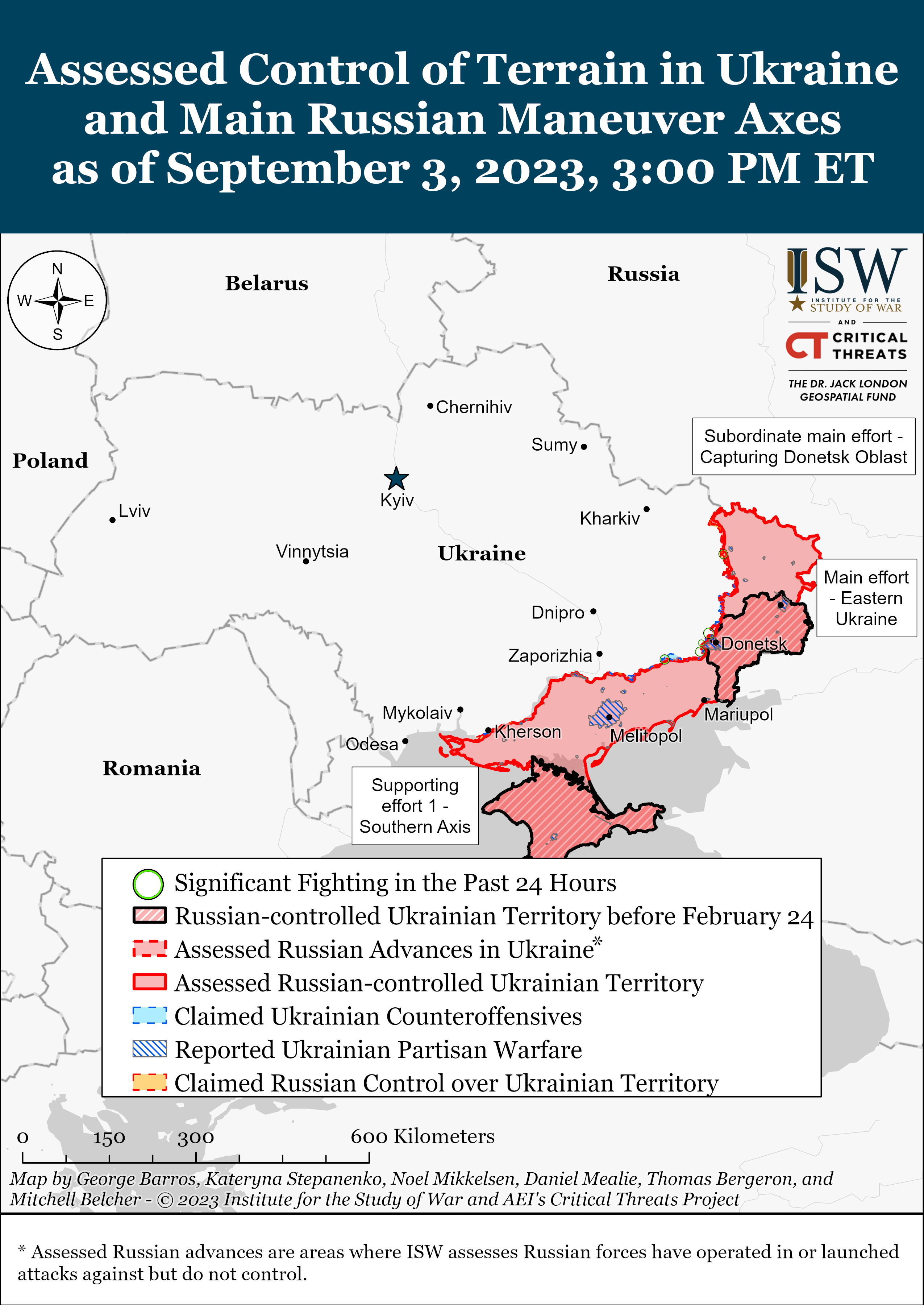
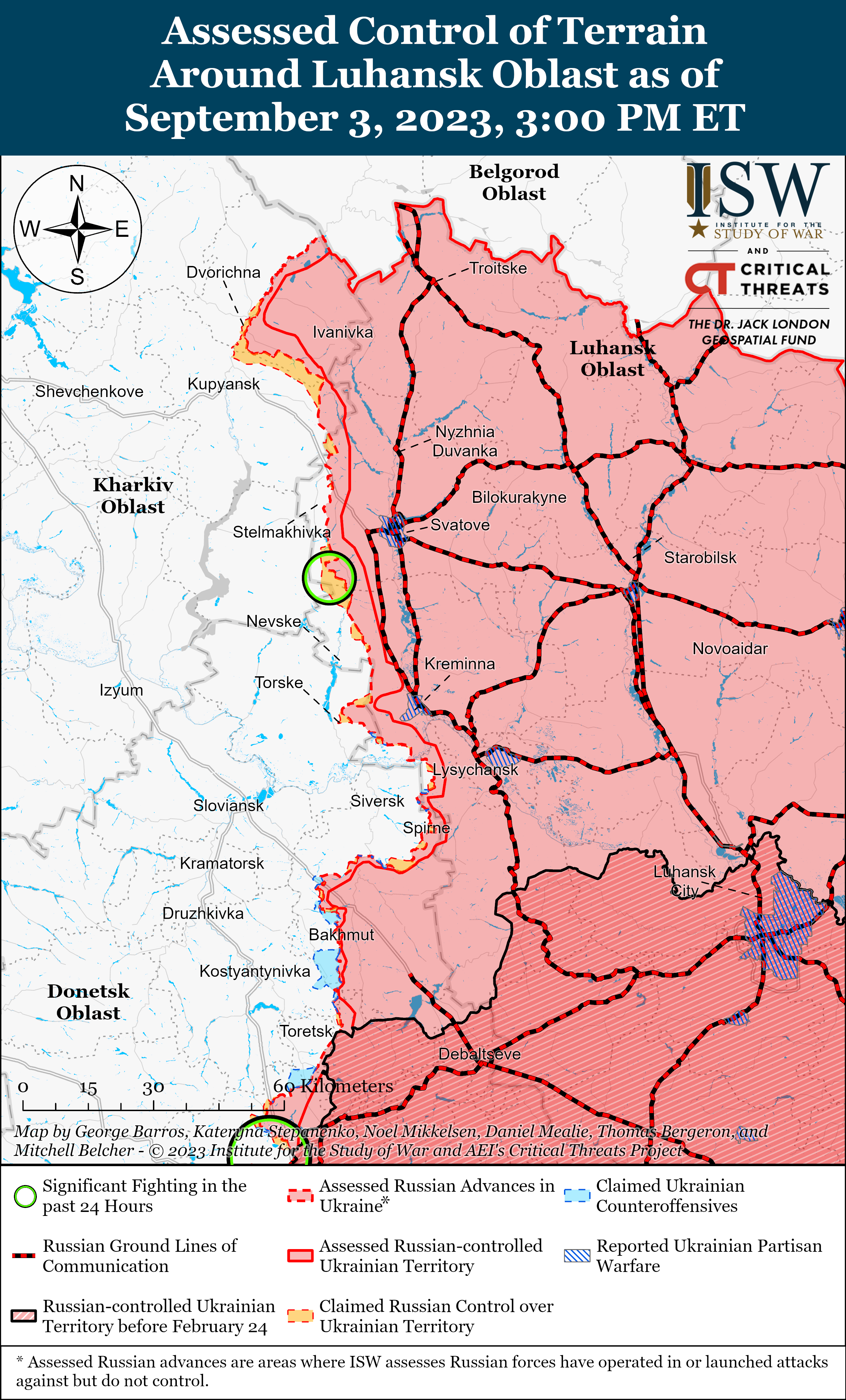
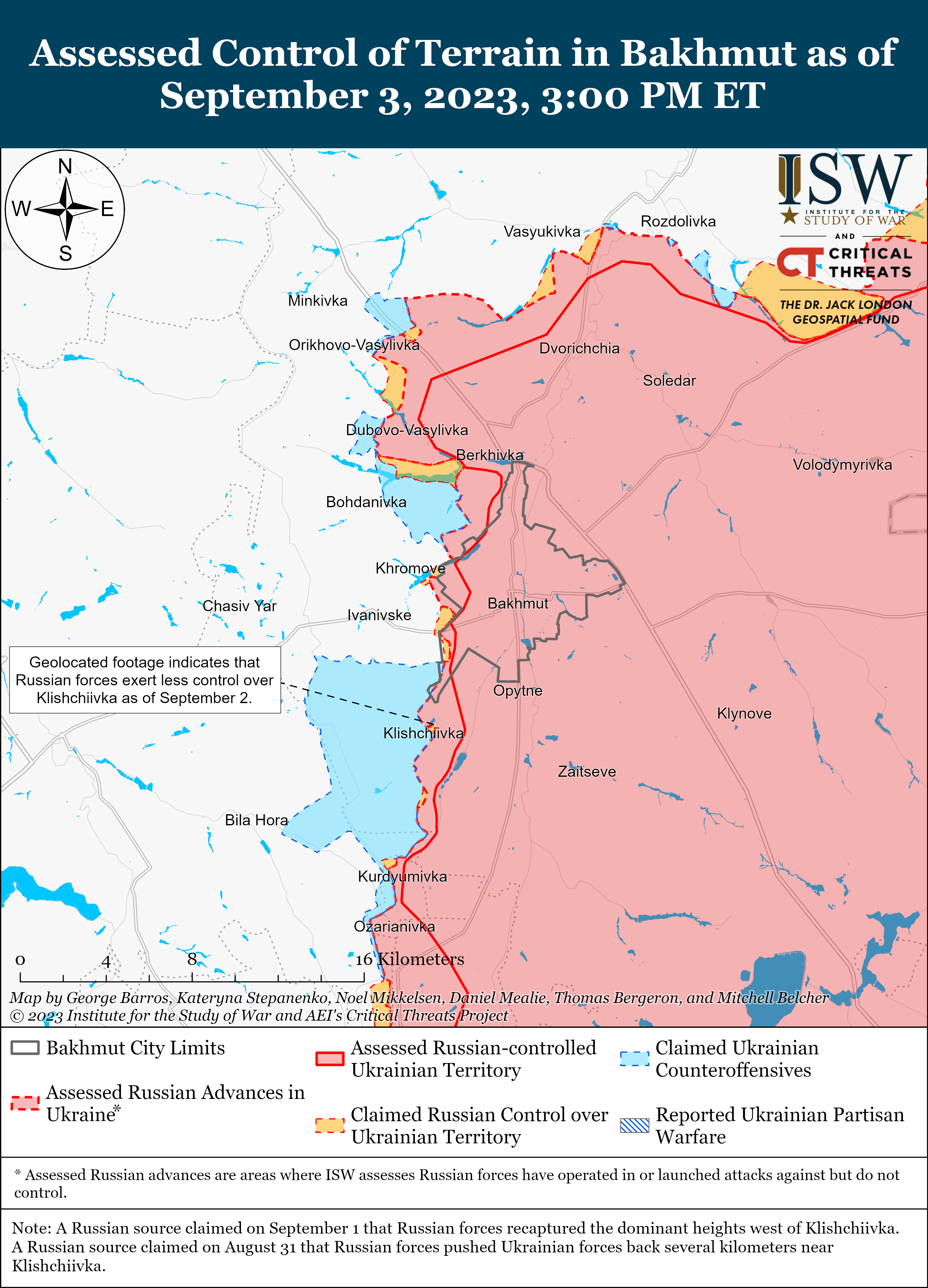
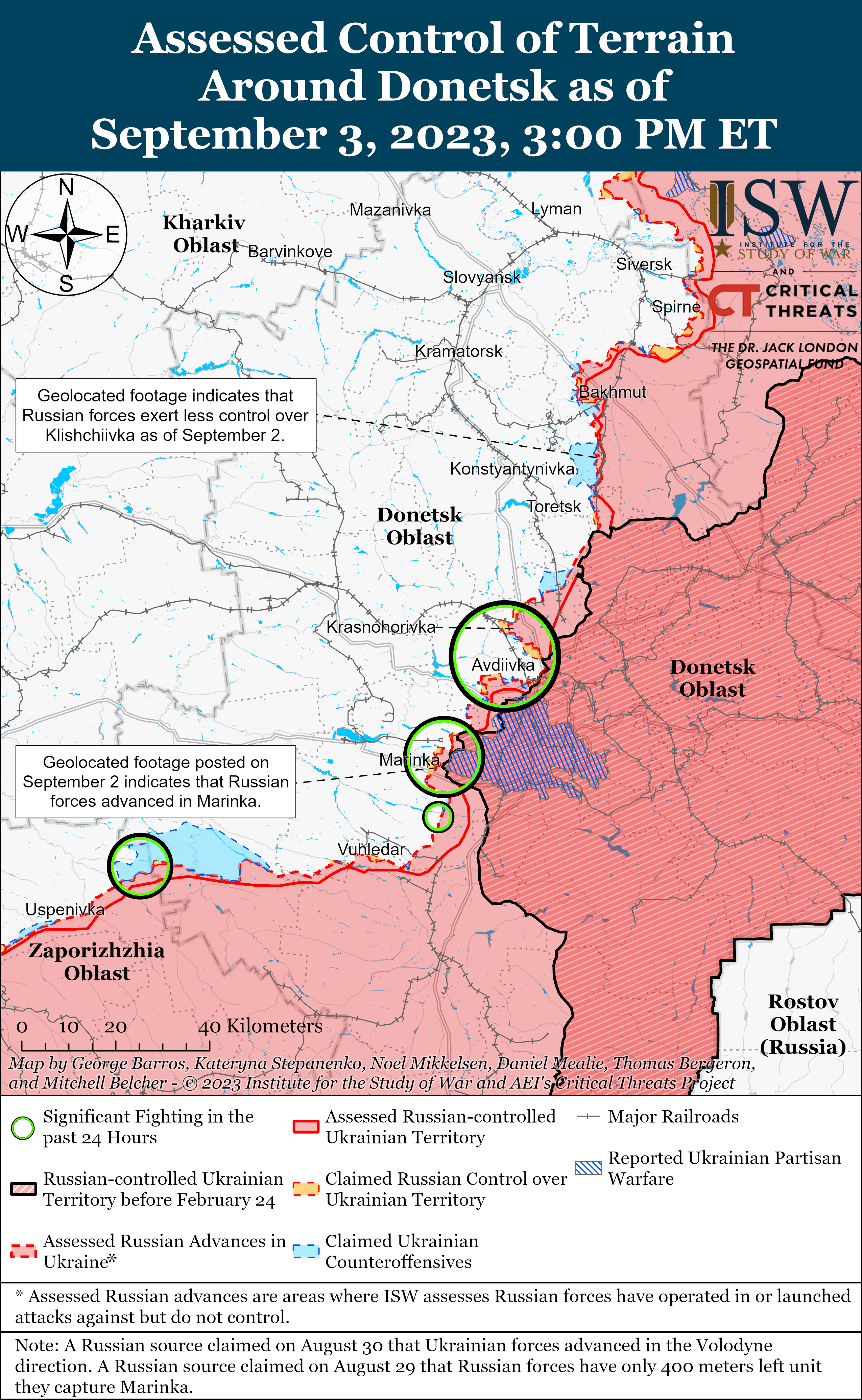
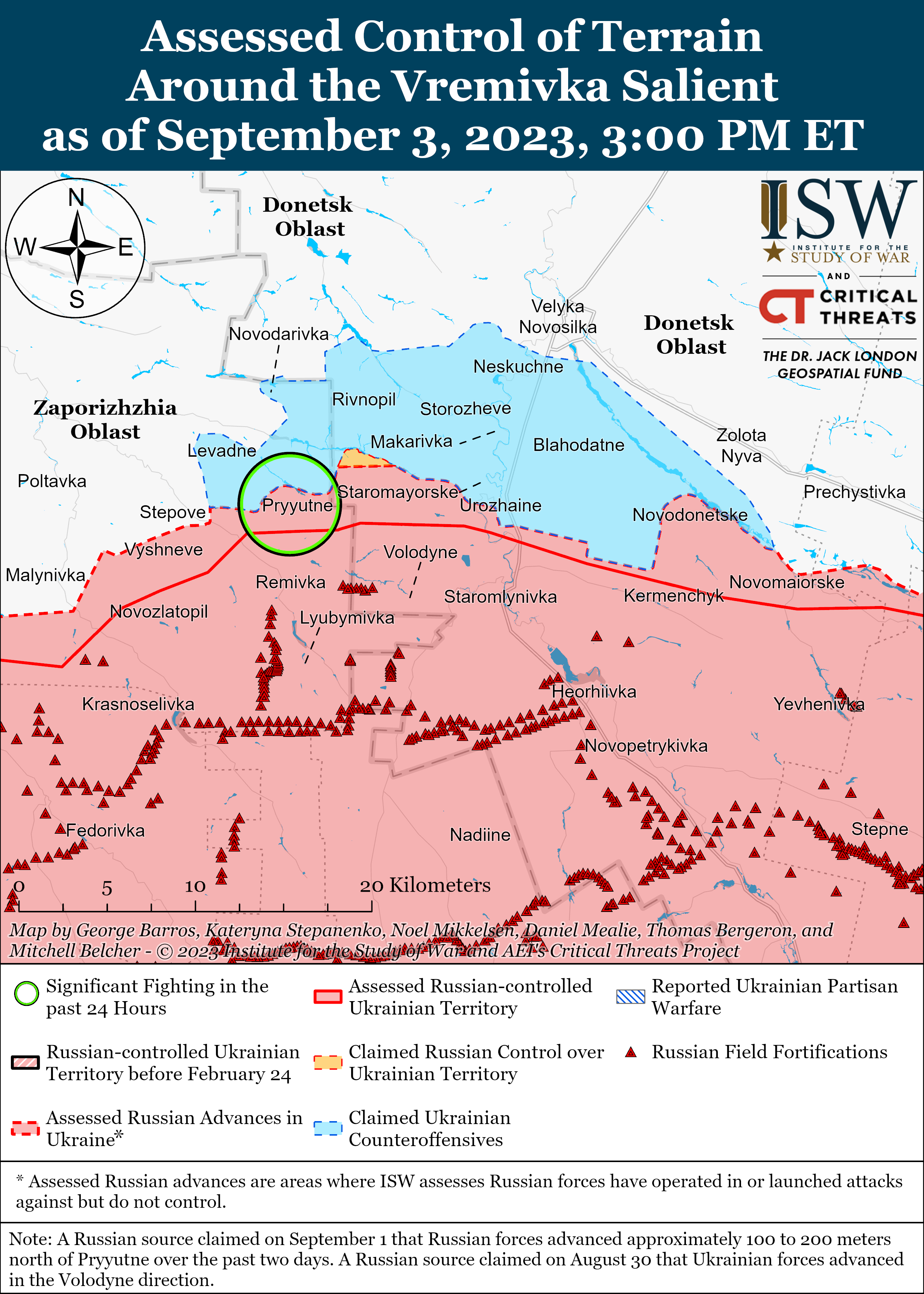
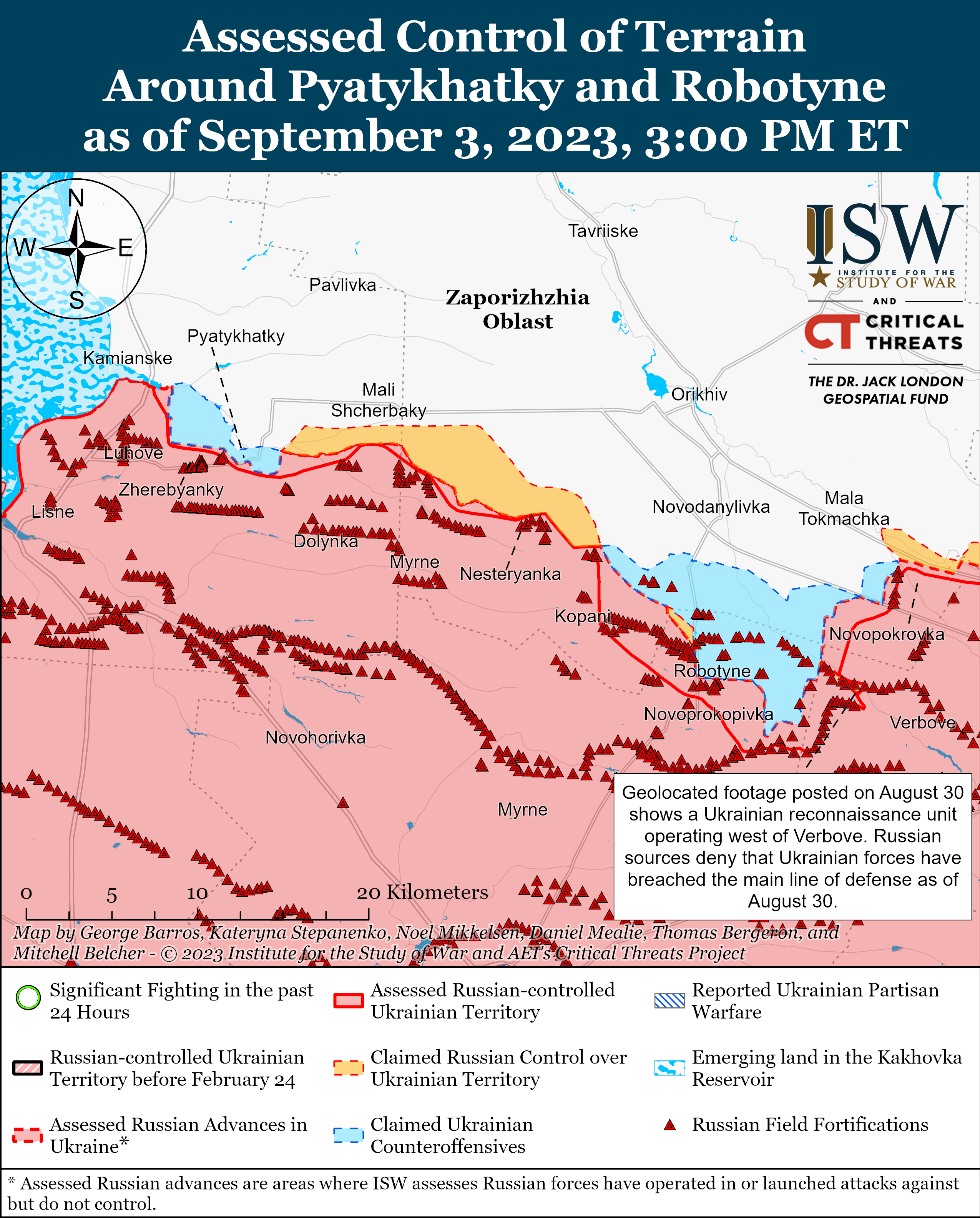
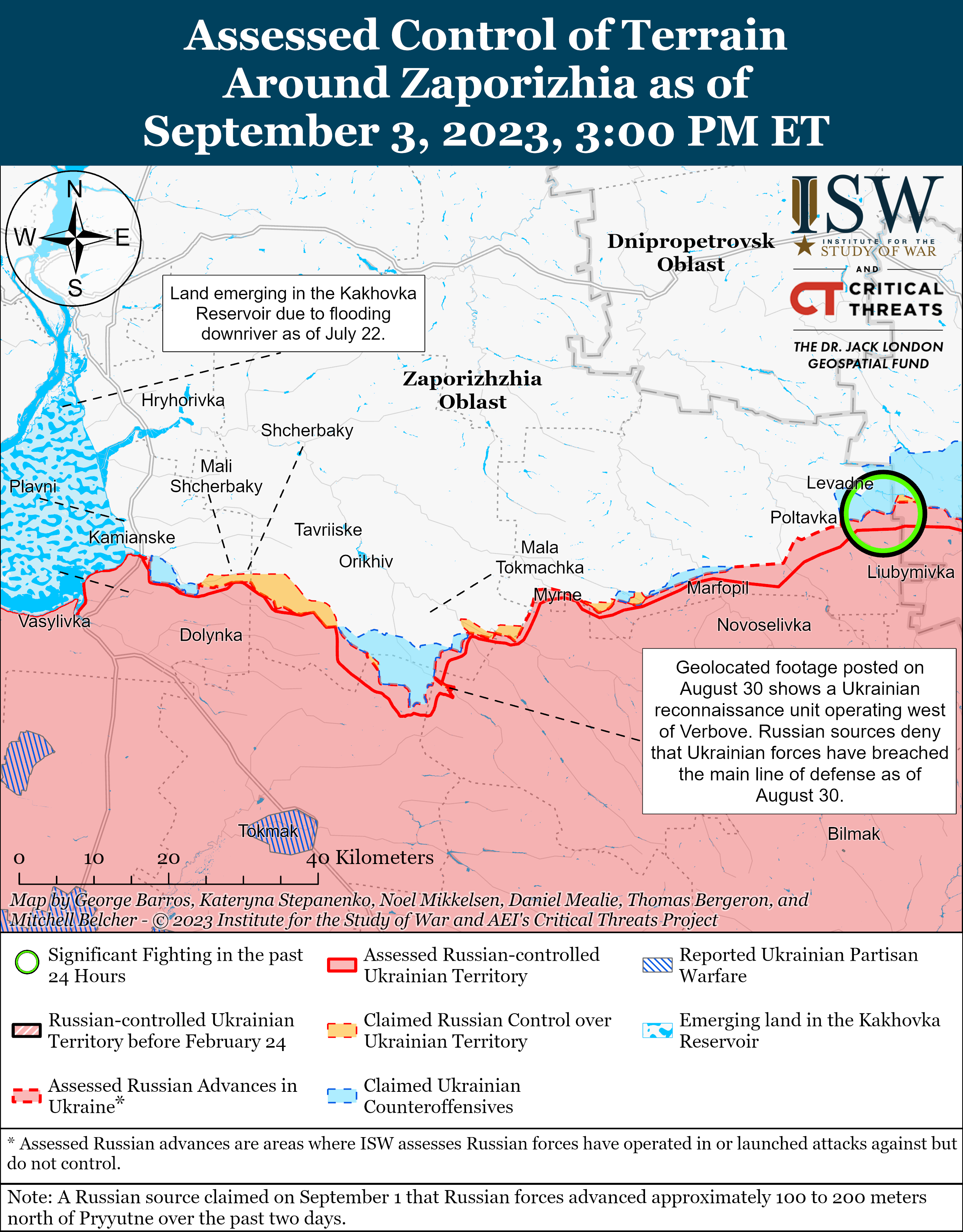
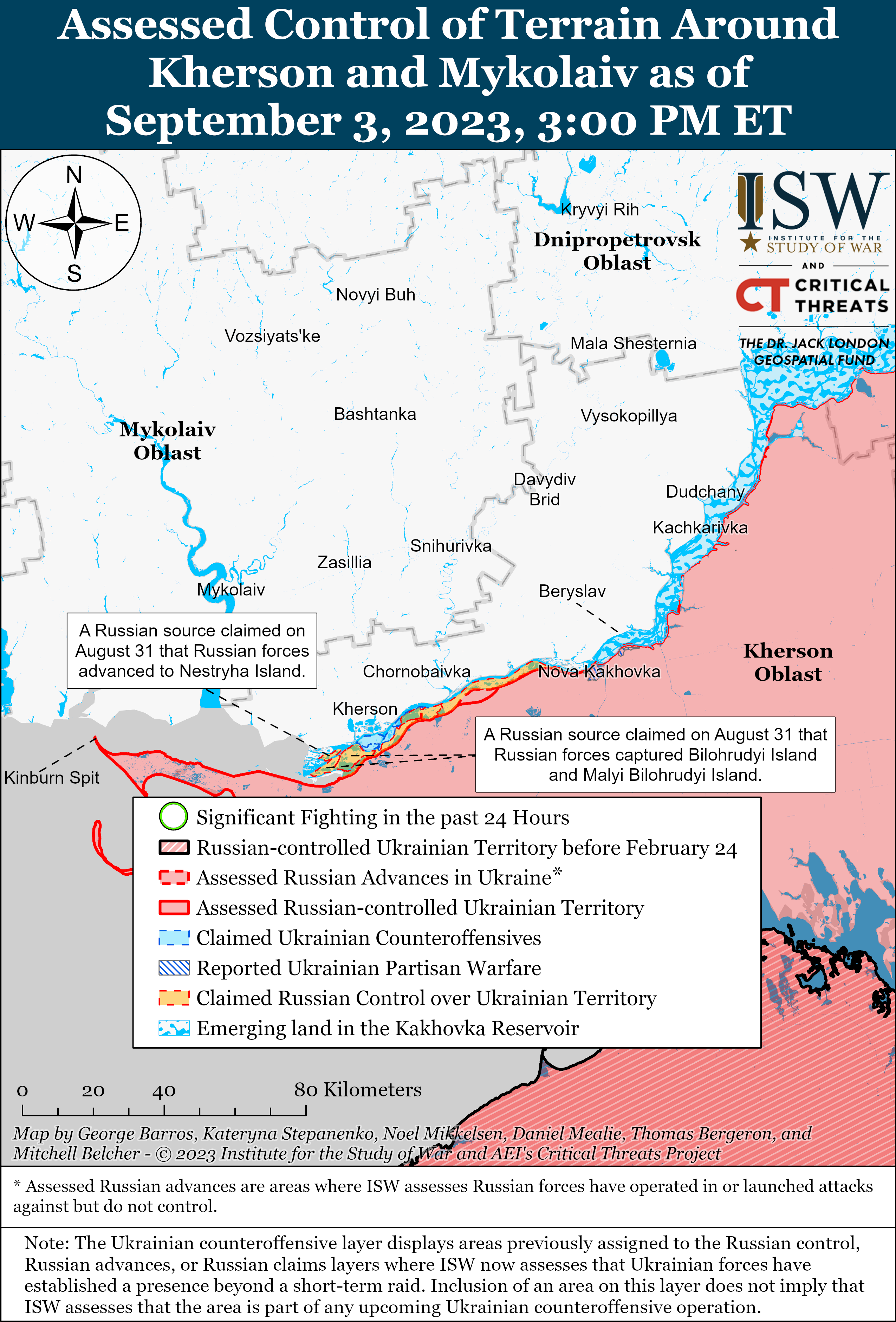
No comments:
Post a Comment